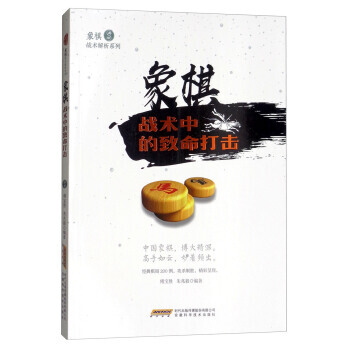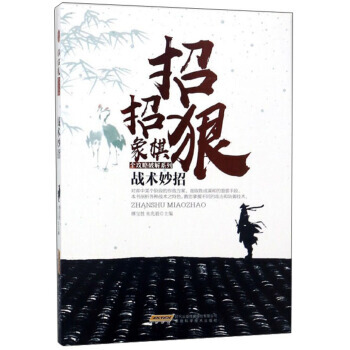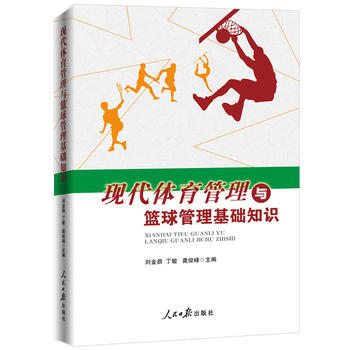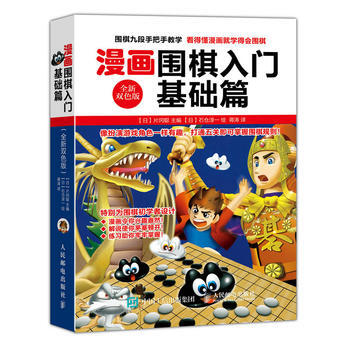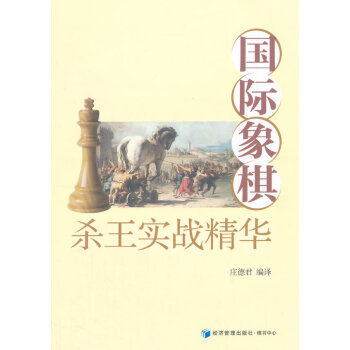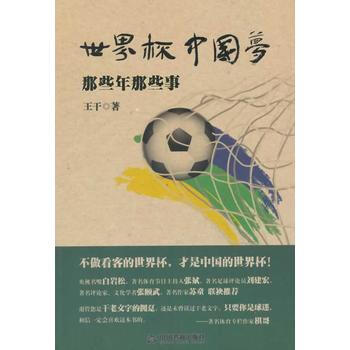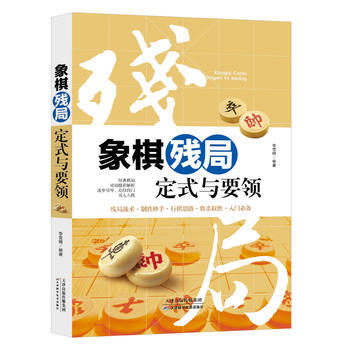具体描述
基本信息
书名:象棋战术中的致命打击/象棋战术解析系列
定价:20.00元
作者:傅宝胜,朱兆毅
出版社:安徽科学技术出版社
出版日期:2017-06-01
ISBN:9787533772383
字数:
页码:148
版次:1
装帧:平装
开本:16开
商品重量:0.4kg
编辑推荐
内容提要
运用战术技巧有两大显著特征:一是巩固扩大优势,直至攻杀制胜;二是处于劣势局面时,往往能够化验为夷起死回生,有争胜谋和之功效。
《象棋战术中的致命打击/象棋战术解析系列》共分五章,精选国内外重大赛事中的经典棋例200例,皆为攻杀制胜型,书末系统介绍了施展战术要达到的十三种战术目的,以及对二十五种常用的战术名词加以解读,便于读者对战术的理解和恰当的运用。编写该书的目的旨在为棋友们学习、欣赏、研究象棋大师们的棋艺提供一个指导性的平台,对提高实战中战术运用的技巧有所帮助。
目录
章 弃子抢杀一剑封喉(共40局 )
局 困子战术——万春林扬象困马
第2局 闪击战术——庄玉庭闪车捉卒
第3局 记子战术——苗永鹏兑子硬拼
第4局 冷着战术——徐天红冷着制胜
第5局 牵制战术——杨德琪横牵谋炮
第6局 兑子战术——郭莉萍三兑取势
第7局 引离战术——张国凤槽马引车
第8局 牵制战术——文静妙牵成巧和
第9局 捉子战术——于幼华退马双捉
0局 闪击战术——党斐连施闪击战
1局 弃予战术——陈富杰贪车致败
2局 堵塞战术——黄泗妙演“铁门栓”
3局 封锁战术——庄宏明横卒封车
4局 闪击战术——“雄鹰”展翅破敌营
5局 双重威胁——伍霞进车呈双杀
6局 兑予战术——励娴连兑构绝杀
7局 抽将战术——梅娜争先造抽将
8局 抽将战术——王利红烈马抽车
9局 吸引战术——陈丽淳调敌争先
第20局 弃子战术——王小雨弃车入局
第21局 牵制战术——谢靖惨遭全牵制
第22局 吸引战术——邬正伟弃车吸引
第23局 拦截战术——陈孝堃弃马拦截
第24局 吸引战术——徐天红海底捞月
第25局 运子战术——黎德志调运取势
第26局 捉子战术——欧棋亮频捉杀入
第27局 抽将战术——郑一泓腾挪抽马
第28局 封锁战术——锁帅门一气呵成
第29局 捉子战术——谭邦捉运巧组合
第30局 腾挪战术——“牡丹王”运子腾挪
第31局 弃子战术——高维铉弃车成“癖”
第32局 困子战术——孙勇征困马有方
第33局 弃子战术——郭瑞霞弃子攻杀
第34局 兑子战术——郑熙明兑车入局
第35局 引离战术——宋国强弃车引离
第36局 抽将战术——郑一泓两抽制胜
第37局 闪击战术——万春林退炮献车
第38局 拦截战术——徐天红妙施拦截
第39局 弃子战术——高维雄两度弃车
第40局 闪击战术——谢岿妙闪衔车炮
第二章 锁帅门一气呵成(共40局 )
局 拦截战术——谢岿炮拦车取势
第2局 兑子战术——金松一兵兑双士
第3局 捉子战术——“拼命三郎”捉死车
第4局 双重威胁——“梁山帅哥”成“霸业”
第5局 腾挪战术——胡庆阳四面楚歌
第6局 封锁战术——靳玉砚封锁建功
第7局 腾挪战术——卓赞烽运子腾挪
第8局 双重威胁——双重威胁成胜果
第9局 弃子战术——“全民空投”弃车赢
0局 等着战术——胡荣华妙用等着
1局 抽将战术——陈富杰寡不敌众
2局 堵绣战术——王琳娜一招制胜
3局 诱着战术——胡明巧施诱敌计
4局 吸引战术——赵寅妙手引黑炮
5局 捉子战术——文静勇挫张国凤
6局 兑子战术——王琳娜巧兑赚马
7局 抽将战术——胡荣华智取银川
8局 吸引战术——“电脑”勇挫陶汉明
9局 腾挪战术——汪洋腾挪奏凯歌
第20局 引离战术——张晓平先弃后取
第21局 弃子战术——弃马抢攻搏生死
第22局 堵塞战术——宋国强阻炮成功
第23局 困子战术——黄仕清退炮困车
第24局 引离战术——弃车引离铸胜局
第25局 冷着战术——炮轰仕冷着制胜
第26局 抽将战术——刘殿中大战王斌
第27局 迂回战术——陶汉明骏马盘旋
第28局 封锁战术——运炮封锁见功力
第29局 困子战术——申鹏妙施困马术
第30局 腾挪战术——曾启泉运子腾挪
第31局 捉子战术——陈种追击谋子赢
第32局 腾挪战术——陆伟韬顾此失彼
第33局 困子战术——牛保明困子攻杀
第34局 堵塞战术——韩冰力战郭莉萍
第35局 兑子战术——“呼延灼”智取“太阳”
第36局 解杀还杀——陈丽淳解杀还杀
第37局 捉子战术——陈泓盛三捉奏功
第38局 运子战术——汪洋运马巧攻杀
第39局 吸引战术——刘君力挫尤颖钦
第40局 弃子战术——蒋凤山弃车催杀
……
第三章 封堵腾挪一招制胜(共40局 )
第四章 少牵多运蟒缠身(共40局 )
第五章 施冷着图穷匕现(共40局 )
附录 象棋战术名词术语选释
作者介绍
文摘
序言
章 弃子抢杀一剑封喉(共40局 )
局 困子战术——万春林扬象困马
第2局 闪击战术——庄玉庭闪车捉卒
第3局 记子战术——苗永鹏兑子硬拼
第4局 冷着战术——徐天红冷着制胜
第5局 牵制战术——杨德琪横牵谋炮
第6局 兑子战术——郭莉萍三兑取势
第7局 引离战术——张国凤槽马引车
第8局 牵制战术——文静妙牵成巧和
第9局 捉子战术——于幼华退马双捉
0局 闪击战术——党斐连施闪击战
1局 弃予战术——陈富杰贪车致败
2局 堵塞战术——黄泗妙演“铁门栓”
3局 封锁战术——庄宏明横卒封车
4局 闪击战术——“雄鹰”展翅破敌营
5局 双重威胁——伍霞进车呈双杀
6局 兑予战术——励娴连兑构绝杀
7局 抽将战术——梅娜争先造抽将
8局 抽将战术——王利红烈马抽车
9局 吸引战术——陈丽淳调敌争先
第20局 弃子战术——王小雨弃车入局
第21局 牵制战术——谢靖惨遭全牵制
第22局 吸引战术——邬正伟弃车吸引
第23局 拦截战术——陈孝堃弃马拦截
第24局 吸引战术——徐天红海底捞月
第25局 运子战术——黎德志调运取势
第26局 捉子战术——欧棋亮频捉杀入
第27局 抽将战术——郑一泓腾挪抽马
第28局 封锁战术——锁帅门一气呵成
第29局 捉子战术——谭邦捉运巧组合
第30局 腾挪战术——“牡丹王”运子腾挪
第31局 弃子战术——高维铉弃车成“癖”
第32局 困子战术——孙勇征困马有方
第33局 弃子战术——郭瑞霞弃子攻杀
第34局 兑子战术——郑熙明兑车入局
第35局 引离战术——宋国强弃车引离
第36局 抽将战术——郑一泓两抽制胜
第37局 闪击战术——万春林退炮献车
第38局 拦截战术——徐天红妙施拦截
第39局 弃子战术——高维雄两度弃车
第40局 闪击战术——谢岿妙闪衔车炮
第二章 锁帅门一气呵成(共40局 )
局 拦截战术——谢岿炮拦车取势
第2局 兑子战术——金松一兵兑双士
第3局 捉子战术——“拼命三郎”捉死车
第4局 双重威胁——“梁山帅哥”成“霸业”
第5局 腾挪战术——胡庆阳四面楚歌
第6局 封锁战术——靳玉砚封锁建功
第7局 腾挪战术——卓赞烽运子腾挪
第8局 双重威胁——双重威胁成胜果
第9局 弃子战术——“全民空投”弃车赢
0局 等着战术——胡荣华妙用等着
1局 抽将战术——陈富杰寡不敌众
2局 堵绣战术——王琳娜一招制胜
3局 诱着战术——胡明巧施诱敌计
4局 吸引战术——赵寅妙手引黑炮
5局 捉子战术——文静勇挫张国凤
6局 兑子战术——王琳娜巧兑赚马
7局 抽将战术——胡荣华智取银川
8局 吸引战术——“电脑”勇挫陶汉明
9局 腾挪战术——汪洋腾挪奏凯歌
第20局 引离战术——张晓平先弃后取
第21局 弃子战术——弃马抢攻搏生死
第22局 堵塞战术——宋国强阻炮成功
第23局 困子战术——黄仕清退炮困车
第24局 引离战术——弃车引离铸胜局
第25局 冷着战术——炮轰仕冷着制胜
第26局 抽将战术——刘殿中大战王斌
第27局 迂回战术——陶汉明骏马盘旋
第28局 封锁战术——运炮封锁见功力
第29局 困子战术——申鹏妙施困马术
第30局 腾挪战术——曾启泉运子腾挪
第31局 捉子战术——陈种追击谋子赢
第32局 腾挪战术——陆伟韬顾此失彼
第33局 困子战术——牛保明困子攻杀
第34局 堵塞战术——韩冰力战郭莉萍
第35局 兑子战术——“呼延灼”智取“太阳”
第36局 解杀还杀——陈丽淳解杀还杀
第37局 捉子战术——陈泓盛三捉奏功
第38局 运子战术——汪洋运马巧攻杀
第39局 吸引战术——刘君力挫尤颖钦
第40局 弃子战术——蒋凤山弃车催杀
……
第三章 封堵腾挪一招制胜(共40局 )
第四章 少牵多运蟒缠身(共40局 )
第五章 施冷着图穷匕现(共40局 )
附录 象棋战术名词术语选释
chess tactics: The Killer Blows The game of chess, a timeless battle of wits and strategy, unfolds across sixty-four squares, each move a carefully considered step towards victory or a potential misstep leading to ruin. At its heart lies the captivating world of tactics – the short-term maneuvers designed to exploit an opponent's weaknesses, seize an advantage, and ultimately, deliver a decisive blow. This book delves deep into the intricate art of chess tactics, dissecting the most potent and effective methods that have shaped countless games and crowned numerous champions. From the foundational principles of forks and pins to the sophisticated interplay of discovered attacks and sacrifices, this comprehensive exploration offers a rich tapestry of tactical concepts. We will journey through the annals of chess history, examining classic examples and modern masterpieces, to understand how these tactical elements are woven into the fabric of brilliant play. The aim is not merely to present a catalog of tactical motifs, but to cultivate a deep understanding of why they work, when to employ them, and how to recognize opportunities that others might overlook. Chapter 1: The Pillars of Tactical Vision – Forks, Pins, and Skewers Every chess player, from novice to grandmaster, begins their tactical journey with the fundamental building blocks. This chapter focuses on the three most elementary yet devastating tactical devices: the fork, the pin, and the skewer. The Fork: A single piece attacking two or more enemy pieces simultaneously. We will explore various types of forks, including knight forks, pawn forks, and queen forks, and analyze their impact on board control and material advantage. Understanding how to create and defend against forks is paramount to survival and dominance. We will examine scenarios where a seemingly innocuous move unleashes a devastating fork, leading to immediate material loss for the unsuspecting opponent. The psychology of the fork – the impossible choice it presents – will also be discussed. The Pin: A piece rendered immobile or severely restricted in its movement because attacking it would expose a more valuable piece or the king to capture. We will differentiate between absolute pins (where moving the pinned piece results in the immediate loss of the king) and relative pins (where moving the pinned piece leads to the loss of other valuable material). The strategic implications of pins, such as creating defensive weaknesses or setting up subsequent attacks, will be thoroughly investigated. Examples will be drawn from games where players have masterfully exploited pins to dismantle their opponent's defenses. The Skewer: The inverse of a pin, where a more valuable piece is attacked, and if it moves, a less valuable piece behind it is captured. This subtle but powerful tactic can be used to win material or force advantageous exchanges. We will explore how skewers can be employed with various pieces and the conditions under which they are most effective. The book will guide the reader in recognizing the conditions ripe for a skewer and how to capitalize on such opportunities. Chapter 2: The Art of Exploitation – Discovered Attacks and Discovered Checks Beyond the basic trio, tactics begin to reveal their more sophisticated nature. This chapter introduces the concepts of discovered attacks and discovered checks, which leverage the power of movement to create unexpected threats. Discovered Attacks: When a piece moves out of the way, revealing an attack from another piece behind it. This tactic can create multiple threats simultaneously, often overwhelming the opponent. We will analyze the effectiveness of discovered attacks in various positions, demonstrating how they can be used to win material, force checkmate, or disrupt the opponent's coordination. The element of surprise inherent in discovered attacks will be highlighted as a crucial factor in their success. Discovered Checks: A specific and particularly potent form of discovered attack, where the revealed attack is a check on the enemy king. This forces the opponent to deal with the immediate threat to their king, often at the expense of other considerations. We will delve into the strategic importance of discovered checks, examining how they can be used to gain tempo, force king movement into disadvantageous positions, and ultimately, contribute to mating attacks. The concept of a "double check" – where the piece moving delivers check and the piece revealed also delivers check – will also be explored in its full ferocity. Chapter 3: Sacrifices – The Price of Victory Tactics often demand a price. This chapter explores the realm of sacrifices, where material is willingly given up for a greater advantage. Material Sacrifices for Attack: Giving up a pawn, piece, or even the queen to open lines, deflect defenders, or create mating threats. We will analyze the principles behind successful sacrifices, emphasizing the need for clear follow-up lines and a decisive advantage gained from the sacrifice. The psychological impact of a sacrifice on an opponent can be as potent as the tactical outcome itself. Sacrifices for Positional Advantage: Beyond immediate material gain, sacrifices can also be employed to gain long-term positional advantages, such as controlling key squares, disrupting pawn structures, or creating outposts for one's own pieces. This chapter will illuminate how seemingly unsound sacrifices can be strategically justified when they lead to a decisive positional grip. Thematic Sacrifices: Certain tactical patterns, like the Bxh7+ sacrifice on f7 or g7, are so common and effective that they have become recognized as "thematic sacrifices." We will identify and analyze these recurring motifs, providing readers with a keen eye for their appearance on the board. Chapter 4: The Maestro's Toolkit – Combinations and Mating Patterns Building upon the foundational tactical elements, this chapter focuses on how these concepts are combined to create sequences of moves that lead to a decisive advantage or checkmate. The Art of Combination: A sequence of moves involving two or more tactical ideas, often including sacrifices, designed to achieve a specific goal. We will break down the process of constructing combinations, from identifying the initial spark of an idea to calculating the precise variations. The importance of forcing moves and clear objectives in a combination will be stressed. Common Mating Patterns: Recognizing and executing standard mating patterns is a crucial skill for any tactician. This section will cover fundamental checkmating patterns such as back-rank mates, smothered mates, Anastasia's mate, and Legal's mate, among others. The focus will be on understanding the underlying tactical principles that enable these mates and how to set them up. Prophylaxis in Tactics: While this book focuses on offensive tactics, understanding defensive principles is equally vital. We will briefly touch upon how proactive defensive play can often neutralize an opponent's tactical threats, thus highlighting the interconnectedness of offensive and defensive strategies. Chapter 5: Developing Your Tactical Eye – Practice and Calculation The most brilliant tactical ideas remain dormant without the ability to recognize them and calculate their consequences. This final chapter is dedicated to cultivating these essential skills. The Importance of Calculation: The ability to foresee sequences of moves and their outcomes is the bedrock of tactical proficiency. We will discuss methods for improving calculation skills, including visualization techniques, identifying candidate moves, and the concept of forcing variations. The Power of Practice: Chess tactics are best honed through rigorous practice. This chapter will provide guidance on how to effectively solve tactical puzzles, analyze your own games for tactical oversights, and learn from the tactical brilliance of the world's best players. The reader will be encouraged to actively engage with tactical exercises to solidify their understanding. Recognizing Tactical Opportunities: Beyond rote memorization, developing an intuitive "tactical sense" is key. We will discuss how to cultivate this by understanding pawn structures, king safety, piece activity, and imbalances on the board, all of which can signal potential tactical opportunities. This book is more than just a collection of tactical problems; it is an invitation to a deeper appreciation of the dynamic and exciting possibilities that lie within the game of chess. By understanding and mastering these tactical principles, players will not only elevate their game but will also unlock a new level of enjoyment and engagement with the "royal game." The goal is to equip the reader with the knowledge and practice to transform fleeting opportunities into decisive, game-winning blows.
